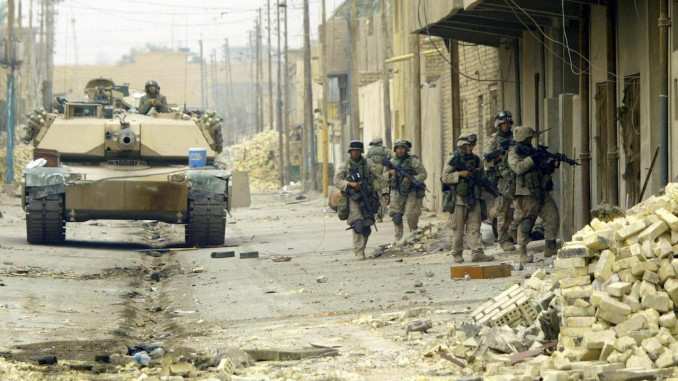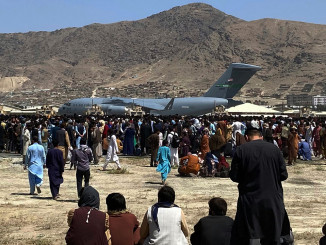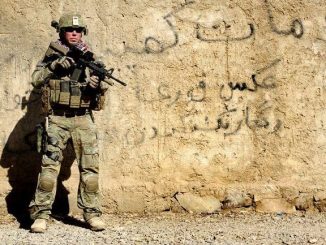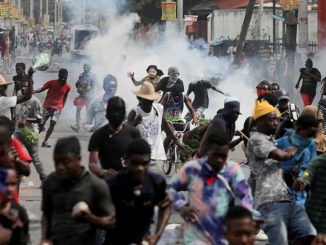
The world just marked the one-year anniversary of Russia’s invasion of Ukraine, but there is also another anniversary — 20 years since the U.S. invaded and occupied Iraq. While the opposition and condemnation of Russia’s brutal war on Ukraine is completely warranted, the denunciations coming from leaders in the U.S. couldn’t be any more hollow when we consider the 20th anniversary of a war they would like us to forget. March 20 marks the 20-year anniversary of the United States leading an invasion that ripped apart the sovereign country of Iraq, stealing the lives of millions of people in the process. The level of devastation seen in Ukraine, while horrendous, is far from what has been inflicted on the people of Iraq.
Iraq Before the 2003 U.S Invasion
Iraq has vast amounts of oil wealth, around the world’s fifth largest known reserves. Controlling this oil wealth has always been a stated aim of U.S. policy since as early as the presidency of Jimmy Carter, who, in his 1980 State of the Union address, gave a clear warning to the rest of the world about the U.S. claim to that oil:
“Let our position be absolutely clear: An attempt by any outside force to gain control of the Persian Gulf region will be regarded as an assault on the vital interests of the United States of America, and such an assault will be repelled by any means necessary, including military force.”
The 2003 invasion of Iraq was not the first time the U.S. invaded the country. In 1991, the U.S. launched Operation Desert Storm. During the six-week long invasion, one thousand bombing runs were made per day, 250,000 people were massacred, and Iraq’s infrastructure was left in ruins. The U.S. did not overthrow Saddam Hussein’s ruling Ba’ath Party regime in that war, but sanctions were imposed that blocked Iraq from selling its oil on the world market, and as a result, Iraq had to enact a food ration program in order to avoid a famine. The sanctions also blocked access to basic resources like essential medicines. These sanctions are estimated to have led to the death of an estimated 500,000 Iraqis, mostly children.
After the 1991 invasion, the U.S. considered strategies for removing Saddam Hussein’s regime, but instead decided on a policy of containment — keeping his regime in place but severely damaging Iraq’s economy with sanctions. The events of September 11th, 2001 changed this. The terrorist attacks on the World Trade Center provided the George W. Bush administration with a pretext to invade the country and finally topple the regime.
A War Founded on Lies
The Bush administration publicly built up the case for war against Iraq over two and a half years, based on a mountain of lies that were pumped out by the corporate media. They knowingly lied when they claimed Iraq had an arsenal of weapons of mass destruction, and was seeking nuclear weapons. These things were obviously false at the time, and have been shown to be false. The Bush administration issued false reports that Saddam Hussein was linked to those who carried out the attacks on September 11, 2001, Osama Bin Laden and Al-Qaeda. In fact, Hussein’s regime had repressed Islamic radicals for decades using all the tools of his police state, including torture. The Bush administration claimed the United States military would bring democracy to Iraq, and would be received as liberators, a lie that would soon become undeniable due to the widespread Iraqi resistance against U.S. forces, who were seen as occupiers. In October 2002, a few months before the invasion, all of these lies were brought to Congress for a vote to authorize the invasion of Iraq, and it passed with overwhelming support from both Republicans and Democrats.
The preparations for war did not take place unopposed, however. All around the world people poured into the streets to protest the wars in Afghanistan and Iraq. The largest demonstrations took place in February of 2003 just before the invasion of Iraq. Around one million people all over the world demonstrated against war on the same day, on every continent. In many cities and towns in the United States people organized the first demonstrations against war ever to take place locally. Anti-war demonstrations continued throughout the eight years of the Bush administration. During his 2008 campaign for president, Barack Obama painted himself as being opposed to the war in order to tap into the widespread opposition in the population. Once he was elected, anti-war demonstrations almost disappeared, even though the Obama administration maintained a U.S. military presence in Iraq.
Iraq Destroyed by War
On March 16, 2003, just before the war began, Vice President Dick Cheney went on NBC’s “Meet the Press” and promised that the U.S. forces would be greeted by Iraqis as “liberators.” Of course, most Iraqis were happy to see an end to Saddam Hussein’s brutal dictatorship, but no Iraqis celebrated the result of U.S. invasion and occupation.
The initial bombing by the U.S. was named “Shock and Awe” by the U.S. military, and leveled Baghdad. The initial attack took the lives of over 7,000 Iraqi civilians within just two months. Immediately following the invasion, the U.S. began dismantling Saddam Hussein’s regime, starting with the entire Iraqi state and the economy. Backed by the occupying U.S. military, the Bush administration appointed the U.S. diplomat, Paul Bremer, to be in charge of organizing a puppet regime in Iraq. All of the former regime’s personnel were fired and dismissed, and the result was an extreme disorganization of public services and government. The already impoverished population suffered immensely. Just six weeks after the invasion, President George W. Bush declared “mission accomplished,” promising that all major combat operations had ended. This too was a total lie. While it is true that the official ruling regime around Saddam Hussein collapsed into retreat shortly after the invasion, the real resistance to the U.S. military was just beginning.
Meanwhile, U.S. weapons manufacturers, military contractors (like Haliburton, whose former CEO was Dick Cheney, the Vice President during the war in the George W. Bush administration), and oil companies made out like bandits. Before the 2003 invasion, Iraq’s oil industry was fully nationalized and closed to Western oil companies. But after a decade of war, it was largely privatized and completely dominated by foreign companies, like ExxonMobil, Chevron, Shell, and BP.
The destruction done to the people of Iraq since the 2003 invasion has been unimaginable. While estimates range widely, depending on the source, between 600,000 to as many as one million Iraqis were killed during the U.S. invasion and occupation. And tens of thousands more are believed to have lost their lives from the general social collapse that resulted from the destruction of infrastructure such as water, sewage, electricity and health care. And the enormous death toll has left hundreds of thousands of Iraqi children orphaned.
Prisoners were held without trial and tortured in infamous facilities like Abu Ghraib prison. Bullets covered in depleted uranium, a radioactive metal used for piercing through armor, were shot at Iraqis. Depleted uranium is cancerous and can stay radioactive for years as it gets into the air, water and ground. Occupation forces also used white phosphorus munitions, a chemical agent used to create smoke, but can stick to the skin and quickly burn it down to the bone. In 2005, doctors noted an alarming rise of infants suffering from serious birth defects as a result of high levels of lead, mercury and uranium, later called “Fallujah syndrome,” named after the major battles that took place in the town of Fallujah. At the time, the U.S. declared the whole city a combat zone and destroyed 60% of the buildings, and the population of the city was reduced by 50% due to evacuation, arrest, or death. Private mercenaries from companies like Blackwater roamed all over the country, terrorizing the population. Entire neighborhoods were destroyed, along with vital infrastructure like roads, water treatment facilities, power plants, hospitals, and more.
By 2007, about 40% of Iraqis from middle income households fled the country with no intent to return. In 2008, unemployment was as high as 70%. The average wage was $150 per month. Consumer goods doubled in price after the occupation began. Only 37% of Iraqi homes were connected to sewer systems. One quarter of Iraqi children suffered from chronic malnutrition. Seventy percent of all childhood deaths resulted from simple diarrhea and respiratory illness. Ninety percent of hospitals lacked essential resources. Within the first months of the 2003 invasion, it is estimated that around 12% of Iraqi hospitals were destroyed, as well as two public health laboratories. By 2013, nearly half of all primary care facilities did not have a doctor on staff and it was estimated that 74% of students under 15 could no longer attend school and dropped out due to violence and financial pressures. And the literacy rate by 2013 had declined to levels not seen for 25 years.
The Costs of War
The war also had huge costs within the United States, with estimates totaling around $3 trillion. This is an enormous amount of money that could have greatly improved the quality of life for millions of people in the U.S. had it been spent on education, health care, housing, infrastructure, or more.
The Iraq war was part of the post-September 11, 2001 so-called “War on Terror,” which has been used to justify the increased militarization of U.S. society, including ongoing military spending increases, mass surveillance by the National Security Agency (NSA), the legalization of mass arrests and imprisonment without trial, and the increased militarization of local police departments around the country.
The war took the lives of 4,491 U.S. soldiers. However, the violence of trauma from the war had a much greater body count than those from physical combat deaths. A study in 2021 found that since September 11th, 2001, some 30,177 veterans who were deployed during that period died by suicide, which is over four times the number of U.S. combat deaths.
The So-called “Withdrawal”
By 2007, the U.S. occupation had not only destroyed much of the country, but had turned the country into a drawn out, internal and deadly conflict due to the power vacuum created by the overthrow of Hussein’s regime, and the dismantling of the Iraqi state and army by the U.S. In the eyes of Iraqis, the U.S. remained an occupying force that they wanted out of their country.
The Bush administration made a deal with the Iraqi government, who by then had become increasingly aligned with the regime in Iran, to withdraw the roughly 170,000 U.S. troops by 2011. And by 2008, the newly incoming Obama administration was happy to cut their losses and go along with this. But even after most of the troops were removed, the U.S. maintained an embassy in Baghdad with some 17,000 personnel, including private military contractors, a mercenary army of 5,500 private security forces paid for by the U.S., and a few thousand so-called “military advisors.” And of course, Obama’s withdrawal of troops did not undo the devastation that left the country in shambles, and paved the way for an escalation in violence to come.
The internal conflict in Iraq escalated once the U.S. withdrew. One of the groups involved in this conflict was named the Islamic State of Iraq and Syria, or ISIS. It was an Islamic fundamentalist militant group, similar to Al-Qaeda. Through its armed militias, ISIS set out to create a “caliphate,” a new state in Iraq and Syria based on their brand of fundamentalist Islam. By 2014, ISIS controlled close to one third of Iraq, where they carried out acts of terror against sections of the population. Soon after withdrawing troops, the U.S. was drawn right back into Iraq to face this new threat.
From 2014 to 2017, the U.S. along with some other forces waged a war against ISIS in Iraq and Syria. Rather than sending large numbers of troops, the U.S. conducted airstrikes, killing thousands of civilians in the process. By the end of 2017, ISIS was no longer a significant threat. While ISIS was a barbaric force, its violence was nothing compared to the magnitude of death and destruction caused by the U.S., whose actions led to the emergence of ISIS.
Iraq Today
While there has been some rebuilding of the country that was so destroyed by the U.S., today the Iraqi people continue to suffer from the decades of war imposed on them. Today about 70% of Iraqi medical staff has either fled the country or been killed. Various studies estimate that as many as 60% of the Iraqi population suffers from PTSD today. Around 70% of Iraqis lack access to clean water and 80% lack basic sanitation. Because of the usage of depleted uranium bullets and other toxic weapons, the water, food and air in various parts of Iraq is projected to be toxic for hundreds of years. In fact there is a strong correlation between the amount of birth defects and the proximity to U.S. military bases and attack sites. In total, over 9.2 million Iraqis were displaced as refugees, whether internally in Iraq or abroad. Much of the country still copes with regular electricity blackouts and lack of clean water.
The United States currently maintains about 12 military bases in Iraq, and has a few thousand troops and military personnel in the country on a permanent basis. After decades of war and a country torn apart, in 2019 and 2020, mass uprisings erupted in Iraq, particularly among working class and poor young people who could not see a viable future for themselves. They opposed the years of austerity and corruption carried out by a government they feel they have no control over. Under the slogan, “we need a homeland,” people across religious and ethnic divisions came to see their struggles as linked in opposition to being controlled by outside forces, whether they be Iran to the east, which has dominated Iraq’s politics since the U.S. invasion, or the U.S. to the West which has imposed decades of war. Because of the U.S. war and occupation, most Iraqis continue to face an extremely impoverished and harsh daily life.
Conclusion
The U.S. invasion and occupation of Iraq is a horrific example of the kind of brutality the U.S. military carries out around the world in order to defend its interests. The U.S., which remains the world’s largest arms dealer, has the largest military budget in the world, with over 750 military bases in 80 other countries, and spends more than most other countries combined. The U.S. has no concern for the sovereignty of other countries or the rights of people in other nations. And the U.S. does not care what effects their wars have on the people of the world, so long as they can profit from these efforts.
Twenty years later, the U.S. war on Iraq must remind us about the level of violence that this entire system of capitalism rests upon. Under capitalism, war, devastation and domination are necessary for the functioning of this system. In order to defend this system of exploitation around the world, the U.S., and other governments rely upon war to impose their rule upon the people of the world.
Another future is possible, one with a world based on respect and cooperation between the peoples of the world, rather than exploitation and domination — a world where the people can live without the horror of wars. But this future requires putting an end to this system. This is a future that is up to us.




